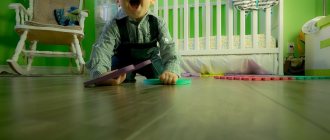During the first year of life, parents closely monitor the achievements of their heir. The child learns to hold his head up, lifts himself up on his arms, rolls over onto his stomach and back, sits down and finally gets to his feet and walks. But for some reason, many adults do not pay enough attention to crawling. This stage most often does not evoke the same parental enthusiasm as the first independent step. It is believed that crawling is just a warm-up and preparation for serious achievements - walking. In fact, this is not entirely correct.
About the benefits of crawling
Crawling is an important stage in a baby's development that should not be missed. Moreover, neurologists believe that crawling has a much greater impact on the further development of the child than the first step. It is during the period of crawling that precedes the first steps that the relationship between the right and left hemispheres of the brain is established. In children who began to crawl early, both hemispheres of the brain are developed, and the predominance of one over the other is insignificant. Early “sliders” are distinguished by their comprehensive development and success, both in the humanities and in the exact sciences.
In addition, at 8-9 months, crawling provides the most optimal distribution of physical activity. The fact is that the emotional and psychological state of the baby is closely related to physical activity. The work of muscles maintains the tone of the central nervous system: the less the child moves, the more passive his perception of the world around him, the more insecure he feels. Hence, in the future, emotional instability, isolation and lack of initiative appear. In medicine there is even such a term - “muscle hunger.” This is when, due to insufficient mobility and passivity, the child may experience physiological disruptions in the body. With insufficient muscle load, the development of the musculoskeletal system, cardiovascular and endocrine systems slows down, blood circulation worsens and metabolism is disrupted. By the way, sedentary children have much lower immunity, they often get sick and have a hard time even with a mild cold.
Crawl or walk?
Some people in a hurry prefer to skip the crawling stage altogether and immediately walk on their own two feet. If a baby at 8-9 months shows persistence in his reluctance to move on all fours, but certainly wants to stand up straight and walk, then his body is ready for such stress. The main thing is that the parents do not rush to put the child on his feet. Their task is to stimulate crawling in every possible way as an important and in all respects useful (provided it is completely safe) process. You can worry about the age at which the baby will go after a year or even a couple of months later.
Parents (especially dads) often think that a child’s early walking is a cause for pride. Therefore, they rush to place their child in a walker. Children really like this device - they get unprecedented freedom of movement. Mothers are also happy: the child is busy, but does not have the opportunity to pick up and eat something from the floor and is at a safe distance from sharp corners. But pediatricians say that using walkers is harmful for the following reasons:
- the child does not have the opportunity to learn to maintain balance, is deprived of the necessary experience of falling, and therefore is afraid to walk independently and eventually starts later;
- premature stress on fragile muscles and the spine can lead to curvature;
- when traveling on a walker and walking independently, different motor skills are used - in order to move the assistive device, you need to push off with your toes, and this is fraught with improper formation of the arch of the foot and walking on tiptoes in the future;
- The walkers themselves can cause injury if the baby runs into a threshold, toy or other obstacle at high speed.
Walkers can be used starting from 9 months of age, and no more than 1 hour a day. The recommended duration of one session is 15 minutes, and it must take place under the supervision of adults.
The time at which children begin to master any motor or cognitive skills has always worried and will continue to worry their parents. In this matter, it is important to focus on time-tested average indicators in order not to miss warning signs and take the necessary measures in time. But if the pediatrician, whom the baby visits at least once a month during the first year, sees no reason for concern, parents should not have it either.
Eight factors of “non-creeping”
Before you begin to develop crawling skills, you need to find out why the child does not attempt to move on all fours. Experts identify eight factors that hinder the development of crawling.
- Underdevelopment of muscles or weakness of the musculo-ligamentous apparatus
(for example, as a result of rickets).This diagnosis is made by a pediatrician during regular examinations. He also prescribes appropriate treatment and massage. If you ignore your doctor’s advice and independently develop your child’s crawling skills, this can lead to serious injuries to ligaments and muscles.
- Overweight
.The children's skeleton is still very weak and is not able to withstand the load of excess weight. An overfed, “obese” child lags behind in physical development, sits up later, and later begins to crawl and walk. It is simply difficult for such a child to move.
- Prolonged stay in bed
(as a result of illness).Children who were sick a lot in the first six to eight months of life often lag behind in physical development. In this case, you should not rush things. Having grown stronger, the child will quickly learn to crawl.
- Limb injuries
.If there are broken limbs, sprained ligaments, or severe bruises, it may be painful for the child to crawl. In this case, you will need the help of an orthopedic doctor and massage therapist.
- "Tight swaddling"
.Being in comfortable blouses and rompers from the first days of life, the child learns to feel his body earlier, moves more and, therefore, begins to crawl earlier. If you are a supporter of “tight swaddling” or it is recommended for your child for medical reasons, place your baby without diapers as often as possible. It is necessary to provide the baby with freedom of movement from birth.
- Prolonged stays in a playpen or walker
significantly slows down the development of crawling skills.Of course, you shouldn’t give up on a life-saving playpen or walker. The most important thing here is not to abuse it and not lock your baby behind a net for the whole day. A child under one year old should not be in the playpen for more than two hours a day and preferably no more than 30-40 minutes at a time. The same goes for walkers.
- Hereditary predisposition
.Experts have found that the norms of physical development are inherited, with boys most often developing like their fathers, and girls being like their mothers. For example, if dad first walked, and only then learned to crawl, there is a high probability that his son will follow his example. So before you complain about your child, ask your parents about how you developed.
- Laziness, lack of interest
.Laziness is an innate quality. Only some kids are too lazy to crawl, while others are too lazy to play with a rattle or listen to fairy tales. And the task of parents is to awaken in the child an innate sense of curiosity, which can overcome laziness.
Features of the development of boys and girls
Girls and boys achieve these developmental milestones at different times. Nature arranges it in such a way that girls are ahead of boys in their development; already at birth this gap is 3-4 weeks. Girls take their first steps 2-3 months earlier, and with their first words they are 4-6 months ahead of boys.
Ability to sit in girls
Elegant girl posing while sitting on the sofa
Girls with average weight and a normal rate of development usually:
- by six months they can sit with the support of an adult;
- upon reaching seven, hold the back straight independently;
- By eight months they are in a sitting position from lying down/on all fours.
This is an average indicator, a deviation from which by a month or a month and a half is also considered normal. Each child is individual and has its own pace of development.
Did the girl sit up too early? So she was ready for this. The main thing is to limit the time your daughter spends sitting. Up to six months it should be no more than an hour a day. The baby likes to play and look at the world around her while sitting, but her spine is not yet strong enough to be subjected to such stress.
When can a girl be seated?
In this matter, girls are a little more whimsical than boys. Due to early sitting down (if the child does not attempt to sit down himself), girls may experience problems with pregnancy in the future associated with deformation of the birth canal. There is also a common medical myth that the consequence of early sitting down can be a bend of the uterus. But this is not so, the bending of the uterus is just a variant of normal physiological development (as well as a slightly backward displacement of the genital organs), which has nothing to do with the girl sitting down in infancy.
As soon as your daughter has independently assumed a sitting position, you can sometimes try to help her sit down, but not earlier than six months of age.
How do boys start to sit?
Healthy babies usually make attempts to sit up from the age of 5 months; you should not interfere with this. But by the fourth month, the boy’s spine is not yet ready for long-term stress.
As soon as the baby begins to make attempts to sit down, you can begin to gradually accustom him to this position, be sure to carry out exercises and massages. Pediatricians do not recommend doing this until the child is six months old and until he begins to try to sit up on his own.
By 7 months, boys can usually sit up with assistance and can then begin sitting up. By 8 months the boy will be able to support his back independently, and a little later he will be able to take a sitting position from a lying position or on all fours.
The average age at which children master some motor skills is presented more clearly in the following table:
| Skill | Girls | Boys |
| First attempts to sit up, rolling from back to stomach and back | 4-5 months | 5-6 months |
| Sitting with assistance | 6 months | 7 months |
| Can be seated | Not earlier than 6 months (if before that the child attempted to sit up on his own), no more than an hour a day. | Not earlier than 6 months (if before that the child attempted to sit up on his own). |
| Holds your back | 7 months | 8 months |
| Assumes a sitting position from a lying position and on all fours | 7.5 – 8 months | 8.5 – 9 months |
Learning to crawl
By five to six months, the baby learns to control his body and master coordination. He tries to roll over from his back to his stomach and, conversely, can grab a small toy suspended above the crib, rises on his arms while lying on his stomach and is able to stretch his hand forward. This indicates that the child’s body is ready to crawl. But the physical readiness of the body is one thing and practical skills are quite another. There is a widespread belief that only weakened children who are developmentally delayed need help in developing crawling skills, while a healthy baby will gradually master everything on his own, the main thing is not to disturb him. This is not true. Some children, indeed, having felt the strength in themselves, try to move independently on four points. But most kids need parental help.
Of course, over time, the child will definitely learn to crawl and walk, but it will be much more difficult for him to do this than for others. Therefore, it is undesirable to let everything take its course. It happens that a child at three or four months develops in accordance with the norm, and parents stop working with him. As a result, by six months a child, healthy from birth, develops problems, and his development lags significantly behind his peers.
Air baths and massage help prepare a small body for crawling. Moreover, it is necessary to deal with the physical development of a child from the first days of life, and not wait until the baby grows up a little. Under the influence of massage, blood circulation and metabolism improve in the skin and muscles and as a result they become more firm and elastic. Basic skills of preventive massage will be shown to you before discharge from the maternity hospital or during home patronage. Infants are massaged twice a day for about ten minutes - in the morning and in the evening before bathing. The main techniques of “home” massage for infants are stroking and rubbing. All movements should be light, gentle and smooth, from the periphery to the center (from the hand to the shoulder, from the foot to the inguinal fold). The child’s arms and legs are not straightened during the massage, but rather slightly bent.
It is useful to carry out exercises based on unconditioned reflexes. So, running your fingers along the spine causes it to straighten, and when you touch the feet, the baby begins to push off. Regularly place your baby naked on his stomach on a hard surface (such as a changing table). In this position, the child learns to raise his head, then leans on his hands and sways on straightened arms, and as a result begins to crawl. The prone position in itself helps strengthen the muscles of the back, neck and shoulders.
After three months, basic physical exercises are added to the massage: crossing arms and legs, circular movements with arms, sitting down, arching, turning from back to stomach (first with the help of the mother, and then independently), etc. As a rule, having learned to independently roll over from back to stomach, the child makes his first attempts at crawling.
But you can often observe a situation where a physically developed and healthy baby does not make any attempts to crawl, although physiologically he has long been able to do this. And vice versa, a weak, painful, but curious baby is actively crawling. The main conclusion follows from this: it should be interesting for a child to crawl. In order for a child to have a desire to move on, parents only need to push him a little and give him an incentive for further discoveries. The most important thing is to be interested. Place the baby on his stomach on a hard surface. Naturally, the baby should be full and satisfied. Place a beautiful toy (preferably musical) at a short distance from the child. The toy should not lie too close so that the child cannot reach it with his hand, but not too far away so that he can reach it by slightly raising himself on his hands and swinging forward. Let the baby reach for them himself; curiosity will definitely take over. Gradually move the “bait” further and further.
When a child is ready for new skills and abilities
To understand this you must
A few points to keep in mind:
Is it time to sit down?
If your child begins to confidently and actively roll over from his back to his tummy and back, he is able to feel his balance and soon
the time will come for him to sit up on his own.
This usually occurs at 6-7 months.
A baby is ready to start crawling if he:
* sitting on the side,
leans on one handle, and the other reaches for the toy, but at the same time holds himself and
does not
fall back;
* standing on all fours:
– leans forward, pulls one hand, knocks it on the floor or tries to grab an interesting toy in front;
– rocks back and forth, keeping the back parallel to the floor and not
bending it;
– moves backwards: this happens because at first it is difficult for him to lift the handle and move it forward, but he really wants to move and explore new territories;
* lying on stomach
, bends the leg under the tummy on its own, or you bend it yourself (it should remain bent), and at the same time the baby tries to crawl.
These moments mean that the baby is developing correctly and slowly,
can bear his own weight, his side muscles and shoulder girdle muscles have become stronger and he will soon begin to crawl. As a rule, this occurs at 7-8 months.
Go already?
When your baby is sitting and crawling steadily, so that you have trouble keeping up with him around the room, he is ready for the next stage - walking.
Children begin to walk confidently at 11-15 months of age.
However, it is not enough to know when a child is ready to learn new skills and abilities. Your task is to help your baby acquire them correctly
, so as
not
to harm your health.
Cause for concern
In some cases, parents are not able to cope without the help of specialists (neurologist or orthopedist). Here are a few key points that should alert you and be a signal to immediately consult a doctor:
- By eight months, the child does not even make weak attempts to crawl. Doesn't rise on its arms and doesn't try to move its whole body forward.
- When learning to crawl, the baby stays at one stage for too long (more than a month) (for example, he learned to swing on all fours and stopped there).
- An eight- to nine-month-old baby crawls, pushing off with his legs, but without lifting himself up on his arms, or crawls, lifting himself up with only one arm, and simply drags the other along the floor. At the same time, during the game he uses both hands.
- The child crawls only backwards. Many children first learn to crawl backwards and only then forwards. But if a one-year-old baby, trying to take independent steps forward, continues to crawl exclusively backwards, this is a serious alarm signal.
How to teach your baby to sit, crawl and walk
It's actually quite simple. It is enough that you:
* followed the instincts of the child, which are inherent in nature;
* instilled in him new skills and abilities
in accordance with physical readiness for the next stage of development by performing a set of exercises.
It's not difficult, the main thing is not
get ahead of events.
Sitting exercises
Their goal is to strengthen the muscles of the shoulder girdle and back.
1. Teach your child to focus on his elbows.
Place him on the floor, press one arm to the floor with your full elbow, and with the other help him act: reach for the toy. During the exercise, make sure that the baby’s legs do not strain, and that one of them (opposite to the active arm) is bent - this will provide stability. Then change the handles.
2. Teach your baby to lean on his free palms.
Sit on the floor, stretch your legs and place your baby on your thighs with her tummy. After this, place his palms on the floor, after placing a bright object in front of him so that the baby reaches for it.
During the exercise, hold the toddler by the sacrum and lower back so that he does not
fell forward.
3. Strengthen your muscles using various aids:
* Exercise on a small oval ball.
Place the child on the ball with his tummy, and in front of him a bright toy. Then place your baby's hands on the floor. In this position, make rocking movements forward, while the child will reach for the toy. During the exercise, hold the baby's sacrum and lower back with your hand.
* Exercise on a large round ball.
Place the child on the ball with his tummy, hold him by the sacrum and lower back with one hand, and bend one leg with the other. Then start swinging the ball from side to side, periodically bending one leg then the other. It’s good if the baby begins to alternately take one hand off the ball and reach for the object that interests him.
* Build an obstacle course.
Take an ordinary sofa cushion and place it on the floor, then place your baby on it with his tummy, and in front of him - an interesting toy. Then place the baby’s palms on the floor and alternately bend one leg and then the other, helping him crawl forward towards the goal.
During the exercise, if necessary, hold the baby by the lower back and sacrum with your hand.
4. Teach your baby to rock on all fours.
Place the child on all fours and rock him back and forth, holding him by the buttocks and thighs so that the legs are slightly bent under the body.
Doing all the exercises every day, you probably ask yourself the question: when will your child sit down? It’s simple: if he, sitting on his side and leaning on one hand, lifts the other off the floor, a “drum roll” is quite appropriate, since the child has already acquired the skill of sitting.
Now you can safely move on to the next stage - learning to crawl.
Crawling exercises
The goal is to strengthen the muscles of the shoulder girdle and deep back muscles, as well as the lateral muscles.
All exercises that help master the skill of sitting also prepare the baby for crawling. However, this is not enough, so this complex needs to be supplemented.
1. Pat your tummy.
A baby who is preparing to crawl, as a rule, has not yet strengthened his muscles. Therefore, standing on all fours, his back bends. To correct this, lightly pat the tummy - then the baby will tense up and try to keep his back straight.
2. Overcome obstacles.
Place a bag filled with plastic balls or pillows on the floor and help your little one overcome this obstacle on all fours.
3. Play "tunnel".
Lay a long tablecloth or blanket on the table so that the edges hang down to the floor. Thus, you will get a homemade tunnel, at the end of which there is a favorite toy or a mother calling the baby to her.
3. Crawl with your baby.
At the age of 7-8 months, the child becomes a small repeater,
so it will be great if you “move” on the floor with him for a few days.
A baby who wants to explore the world will quickly learn a new skill by repeating various exercises, such as crawling behind a moving toy, walking through a tunnel, and others.
4. Strengthen deep muscles.
A toddler is happy to learn new skills if he has a goal to which he strives - a favorite toy. However, it is wrong to place it straight ahead, since it is difficult for him to move forward. Therefore, it is much better if the toy is located on the side of him. Then your child, leaning on the handle, reaches his goal easily.
So, one more stage has been passed: the child has learned to crawl. Now you need to consolidate the results achieved and prepare for confident walking. After all, you have to stand on tiny legs and stay on them.
What is considered normal?
If a child is 1.5 years old and cannot walk independently, doctors and parents sound the alarm. For crawling, unlike walking, there is no specific framework that defines the norm and the lag from the norm. Some children first learn to crawl and only then walk. Others, on the contrary, only having learned to move confidently on two limbs, begin to crawl. Both are normal. Although, ideally, it is desirable that the child first masters crawling, and only then walking.
Typically, a healthy child begins to crawl at eight to nine months, and then learns to walk independently. The position on four limbs is beneficial for still weak bones and especially for the spine. In this way, the baby prepares itself for a vertical position. We can say that crawling provides the basis for all movements. A baby who has mastered crawling gradually and naturally learns to sit down from different positions, stand on all fours, on his knees and legs, without leaning on anything with his hands. Here we can draw an analogy with a bicycle. At first, the baby learns to ride a four-wheeled bicycle; he concentrates entirely on pedaling and does not worry about keeping his balance. And only then, when pedaling becomes automatic, the child switches to a two-wheeled bicycle and concentrates on maintaining balance. Having learned to move confidently on four points, the baby naturally moves on to moving on two limbs. But even if your baby first walked and only then crawled, do not disturb him. Let him crawl, and the more, the better.
Don't worry that, having learned to crawl, the child will climb into all the cracks, and this will lead to additional injuries. Children learn to control the situation under the supervision of adults. But do not limit your child’s freedom when he explores the open spaces of your apartment. Parents should only monitor safety, but not prevent the child from learning his capabilities.
Natalya Aleshina










